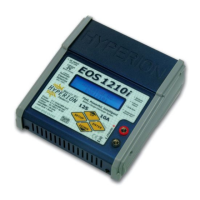when using A123 Mode. The original Hyperion EOSLBA10 can be used, but was originally designed for Lithium
Polymer
batteries.
The EOSLBA10 Balancer function works well with A123, but the overcharge and discharge protection voltages are higher than
optimal for A123. For best results,
EOSLBA10-A
(with LIPO and A123 modes) should be used; when in A123 mode, version
EOSLBA10-A
provides correct protection voltages for A123 cells - both for over-charge and over-discharge conditions.
EOSLBA10-A
should be connected to 1210i via
DataPort Cable (#HP- EOSLBA10-DPC).
Note:
Original LBA10 (w/o A123 mode),
when connected to Hyperion A123-capable Charger via
DataPort Cable, will cause charger to ERROR if charger is set for A123
cell type. Therefore original LBA10 should not use
DataPort Cable when charging A123 cell types.
To help distinguish between Lithium Polymer and A123 Modes, the screen for A123 CELL COUNT lists pack voltages, rather than
“
S
”
count as in LIPO mode. Use the chart below if your pack does not list voltage.
Note on A123 CURRENT (A) setting:
The EOS 1210i does NOT limit max charge rate for A123-type cells. At time of this
writing, A123 cells come only in 2300mAh cell size, but in future other capacities may be available. Current A123 2300mAh cells
are capable
of 4.3C max charge rate (10A). But do consult the documentation provided with your specific A123 pack to
determine max charge rate.
Lead Acid Batteries:
Set Voltage of the battery, Amp Hour (Ah) rating of the battery at BATTERY SETUP screen, and
Charge Current at CHARGE MODE screen. Consult the battery manufacturer’s documentation to determine all of these settings.
NiCd and NiMH:
Set Voltage of the battery, Number of Cells (C), and Capacity in mAh at BATTERY SETUP screen, and
Charge Current at CHARGE MODE screen.
If you only know the nominal rated voltage of the pack, but not the number of cells, divide voltage by 1.2 to get cell count:
Example: 9.6V / 1.2 = 8 , so there are 8 cells in the pack.
At the NiCd/NiMH CHARGE MODE screen, there is a setting for
ψ
: Delta V (
sensitivity to voltage change for charge termination).
If you have no good reason to change the defaults, don’t touch this. By default, NiCd is 8mV/C and NiMH is 4mV/C, in case you
change it by mistake…
Note again that in AUTO modes for NiCd (
A1)and NiMH (A2), you do not need to set anything. Just connect the battery after
choosing the correct Auto Mode, and press ENTER to start charging.
Other Screens and Settings
DISCHARGE MODE:
D
: Discharge rate in ampere (A), 0.1A increments
xV/CELL
: “x” is the stop discharge voltage cutoff per cell
Note: Typically
xV/CELL
would be 0.9V for NiCd/NiMH, 3.0V for Lithium. However, except for testing the condition of a lithium
pack, discharge or cycling of Lithium batteries has no advantage and is best avoided.
CYCLE MODE:
DCH/
CHG
: Choose to Discharge first, then Charge OR
CHG/
DCH
: Choose to Charge first, then Discharge
TIME
: Number of cycles to perform ( 1 = one cycle, 2 = two cycles…)
USER CONDITION SETUP:
The four settings below are global and
affect all memory positions. Push
ENTER
when at the USER CONDITION SETUP screen to
access these four sub menus, then UP/DOWN to make changes (if desired), then
ENTER
again to move to the next screen
(SETUP button is not used at all).
*
TEMPERATURE:
When the optional temperature probe (HP-EOS1210I-SEN) is attached to battery and charger, the
temperature in degrees Celsius at which charging will terminate. Use
UP/DOWN
buttons to choose an appropriate temperature
in a range from 10 to 55 degrees. Press
ENTER
to continue.
*TRICKLE CHARGE CURRENT:
(does not apply to Lithium batteries)
Trickle charge is a low-current maintenance charge that continues after the normal high-rate charge cycle is finished.
AUTO
: Determined by charger algorithm (best in most cases)
0mA
: OFF - No trickle charge
100mA~500mA
trickle charge current, in 100mA increments.
*DELAY BETWEEN CHARGE/DISCHARGE:
Applies only when
in
CYCLE MODE, from 1
~3
0 minutes in one-minute increments.
*
SOUND VOLUME:
OFF
, or one of five choices. Press
UP/DOWN
to hear each tone type.
ENTER
to choose and exit.

